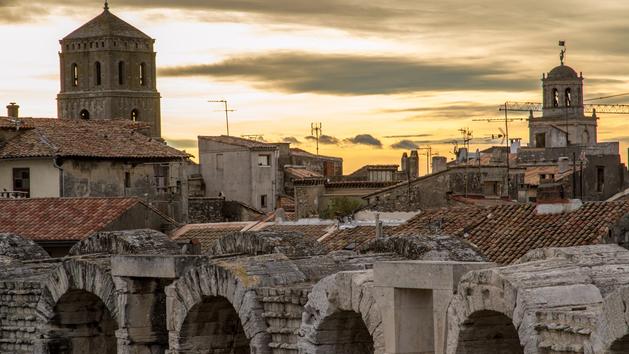Arles returns to its artistic design
Arles' appetite for the arts is not new. As evidenced by the collections of the Musée de l'Arles antique, the Romans, 2,000 years ago already, made the Camargue capital - an anachronistic qualification - a land of creation. In more recent history, it is to Vincent van Gogh that we owe the immortalization of this corner of Provence. Under the leadership of the patron Maja Hoffmann - who spent her childhood here - the Roman city exhibits at least one work by the Dutch Impressionist every year in a museum bearing the painter's name. In town, you can easily follow in his footsteps. Place du Forum, you can sip a “Pac à l'eau” (lemon syrup made in neighboring Vaucluse) in the café where Vincent painted Terrasse du café in the evening . If the yellow housewhere he lived was bombed in 1944 and that the night on the Rhône is now less starry because of the artificial lights of the city, The Arenas are still as alive while the Pont de Langlois still dominates the same canal. The courtyard painted by Van Gogh in the city center is no longer that of the hospital but of a space that bears his name. On a contemporary level, the Luma Foundation likes to exhibit the creation of the moment at the foot of a tower by Frank Gehry. Symbol of a city in motion, it dominates former SNCF workshops.
Good food: Bistro À Côté , by chef Jean-Luc Rabanel. Menu 33 euros. Located a stone's throw from the Hôtel de Ville, this restaurant is next to L'Atelier (2 Michelin stars) run by the same master restaurateur (from € 95).
Next door, 21 rue des Carmes, 13200 Arles. Phone. : 04 90 47 61 13.
Where to sleep: Hôtel L'Arlatan, Hôtel du Forum, Hôtel & Spa Jules César (MGallery) and Le Cloître are emblematic of the city and are all located in the city center.
Read also: From the Luberon to the Alpilles, our best tables in the Provençal region
Les Saintes-Maries-de-la-Mer, between wild nature and tamed land
To explore the land of horses, bulls, unspoiled fauna and flora, the best way is on horseback. Adobe Stock
The road leading to Saintes-Maries-de-la-Mer from Arles or Saint-Gilles (whose facade is listed as a UNESCO World Heritage Site) is a change of scenery in itself. Seeming inhospitable, the surrounding land is in fact an unfathomable wealth. Favorable to the cultivation of rice, the Camargue is also home to a very eclectic fauna. Let's quickly move on to mosquitoes, because bulls, horses (of the Camargue breed of course) and pink flamingos add a much more picturesque touch to these landscapes. For bird watching, the Pont-de-Gau Ornithological Park (adult price 7.5 €), unmissable along the RD 570, is ideal. Less well known, the Reserve du Petit Rhône in Sylvéréal also offers a walk in the heart of 70 wild hectares (adult price € 7). Many horse rides are possible through the pond. Those of Cabanes de Cacharel (from € 18 in a carriage; € 22 in the saddle) are among the most famous. Once you arrive in Saintes-Maries-de-la-Mer, a visit to the church is essential ... as is the tasting of tellines (small shells caught in the sand) in one of the many restaurants, choice, located on the seafront.
Sleeping: Mas de la Fouque Hôtel & Spa, D38 Route du Petit, from € 245; Les Arnelles, Avenue d'Arles, from € 190.
Eating out: There are many friendly restaurants on the seafront.
Read also: Where to go in Provence this summer? Our hidden addresses from Saintes Maries de la Mer to Isle-sur-la-Sorgue
Aigues-Mortes, between salt and earth
Aigues-Mortes, the Salins du Midi. Adobe Stock
In the Camargue desert, the mirage is perfect. Even a few hundred yards away, children think it is snow. In fact of glacier, it is a mountain of salt called Camelle which dominates Aigues-Mortes, fortified medieval city located to the west of the Camargue. It is in these marshes that the famous La Baleine table salt and its fleur de sel are grown. The pink salt tables are thus colored because of the small shrimp which inhabit them and which in turn give this hue to the plumage of the pink flamingos which eat them. From the road leading to Grau-du-Roi we can only see a small part of this farm, the area of which is approximately 100 km2 equivalent to that of the City of Paris! To better understand this wild and controlled space, a guided tour on foot, by bike or by small train is offered (from € 10.80 adult; € 8.5 child; family rate from 4 people).
Many endemic species thrive here sheltered from nuisance. To continue the visit of the city, while cooling off, you have to enter the ramparts closing off the Notre-Dame-des-Sablons church and its stained glass windows designed by the plastic artist Claude Viallat. Clash of cultures, a few tens of meters away rises the Tower of Constance. Formerly a prison, it was the dungeon of Marie Durand, a Cévennes which, in the 18th century, was held here in secret for 38 years because of its Protestant faith. The Camargue, like the neighboring Cévennes, remains a land of combat.
To sleep there: Boutique Hôtel des Remparts, 6, Place Anatole France, from 266 euros.
Eat there: Boem, 253 avenue du pont de Provence (from € 25 starter, main course and dessert for lunch; € 39 in the evening); Le Saint-Amour, 5, rue Sadi-Carnot, from 34 € starter-main course-dessert).

